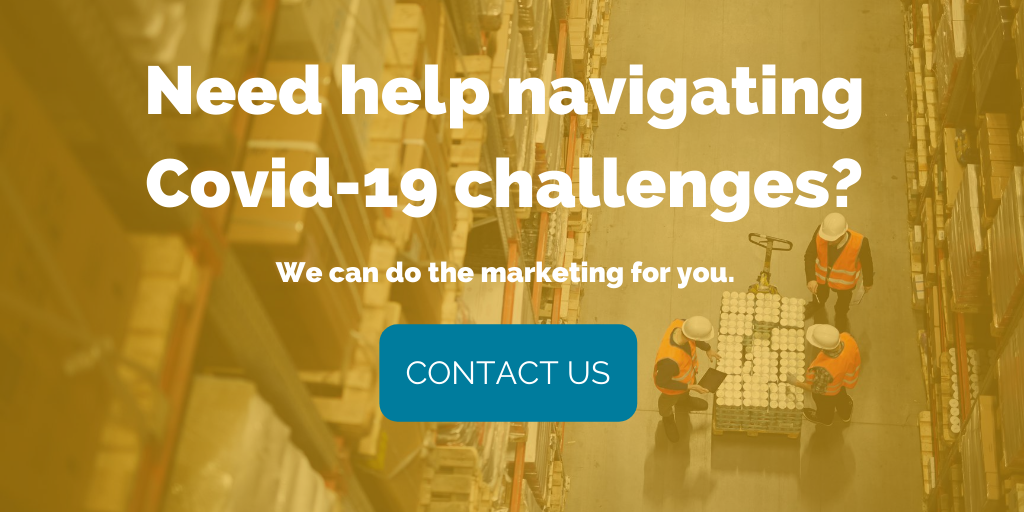
by Fronetics | May 19, 2020 | Blog, Covid-19, Current Events, Marketing, Strategy, Supply Chain
From answering the most important question to humanizing your company, make it part of your Covid-19 messaging strategy.
If your organization put marketing on pause to deal with the impact of Covid-19, it is time to recharge — thoughtfully. But what should your Covid-19 messaging strategy look like? What should you say and where should you say it?
More than any other industry, Covid-19 thrust the supply chain into the eye of the storm. Now, after a few months of intense disruption, a new normal has set in, giving companies in every supply chain vertical a chance to evaluate how to best position their business at a time of great uncertainty.
Since supply chain partnerships are rarely forged overnight, consider the benefits of not only looking after current clients and stakeholders but also extending a hand to new leads. Faced with unprecedented challenges themselves, these potential prospects may be searching for solutions just like yours.
Question is: What will they find when they come across your website and social channels?
Let’s take a closer look at the key components of a Covid-19 messaging strategy for supply chain companies.
Answer the No. 1 question
Yes, you are open for business. Make it clear on the homepage and update your social media profile with the latest facts. Do not let visitors go searching for that one piece of vital information. Although the immediate urgency and upheaval of the first few weeks of the pandemic is waning, the economic repercussions are just starting to be felt, and the question of whether your organization is still in business needs a quick answer. A pop-up message or banner will get the job done. Include a CTA that leads to a landing page on your organization’s Covid-19 response.
Create a dedicated landing page
What is your organization doing to protect employees and clients? Are you experiencing any service interruptions? Do you serve shelter-in-place areas? The landing page can answer all of those questions. Consider the landing page a resource for your clients and prospects. It may include the company crisis communications plan, a direct message from a company executive, links to helpful resources, and more.
Pick the right topics
Like many others, you may have published an initial statement on the crisis and your dedication to helping clients navigate through it. Where do you go from here? Sounding salesy or overly eager to promote your own supply chain solutions can come across as desperate. And moving on like nothing has happened will likely strike visitors as detached.
Take the perspective of your current clients and prospects — what do they want to know about your services at this time? Their priorities have undoubtedly changed since last year.
Many supply chain companies are uniquely positioned to talk about themselves since they truly are part of the solution to the disruption of goods and services. A provider of flexible warehouse space can publish a post on the importance of building a resilient supply chain that can sustain the impact of unexpected events. And an IoT leader may discuss how its fleet app can keep overworked drivers safe.
The voice of the company should echo throughout your site. Update wording that may seem inappropriate or out of place now. Speak with clarity and authority. Give prospects a sense that you really understand what they are going through (because you do). And, most of all, keep publishing relevant content. A dormant blog or resource page sends the wrong message.
Humanize the company
Being able to connect on a personal level with businesses is gaining in significance. Even in the B2B space, it is a strategy that has worked well for many of our clients. This is even more true during a crisis with such a devastating toll on public health as Covid-19.
We have seen CEOs step up to speak directly on camera to clients or let themselves be interviewed about the company’s crisis response. Team members can be featured, too, in video snippets, showcasing any PPE donations or in-the-field work. Videos and personal stories also tend to foster engagement on social media. Again, keep the tone and content aligned with your target audience.
Final word
Your Covid-19 messaging strategy can have a big impact. Think tactful and empathetic. Stay active and engaged. We know this is a challenging time for so many. Getting your messaging right is a good place to start.


by Fronetics | May 13, 2020 | Blog, Covid-19, Current Events, Marketing, Strategy, Supply Chain
With a main lead-generating source canceled or postponed, trade show contingency plans take on increased importance.
The Supply Chain USA 2020 summit in Chicago is a flagship event. Considered a must-attend gathering for strategic decision-making, it draws 1,000 supply chain and logistics leaders for three “unmissable days.”
For executives like Tom Schmitt, chairman and CEO of Forward Air Corp., it is the type of event that generates so many “relevant conversations” that he says it is like getting the value of nine business trips for the price of one.
This year, though, those who planned to head to Supply Chain USA, June 16-18, will need to start working on their trade show contingency plans. The fallout of the coronavirus pandemic has forced EFT, the organizer, to postpone and a new date has yet to be determined.
And — as you have likely experienced yourself — the summit attendees are hardly alone. Within weeks of the Covid-19 outbreak, 1 million people saw their corporate event plans scuttled. MODEX in Atlanta, Ga., in early March, turned out to be one of the last hurrahs for supply chain professionals — half of the pre-registered attendants were no-shows — before cancellations and postponements turned the supply chain conference circuit on its head.
Now, supply chain pros wonder, “What’s next?”
Covid-19 forces domino of cancellations, postponements
A look at this list gives you an idea of the impact: (Check event websites for the latest info)
Trade show contingency plans need to fill big lead generation gap
For supply chain and logistics companies, the cancellations and uncertainty surrounding the postponed shows are no small matters. Trade shows are one of the largest lead generators for B2B demand generation.
Technology and service providers spend an average of 11% of the marketing programs budget on third-party tradeshows, according to the Gartner 2019 Tech Marketing Benchmarks Survey. And the investment seems to be paying off, as 18% of the same companies rank events as the best-performing calls-to-action of marketing-qualified leads, second only to content assets.
Another survey, by MarketingCharts, found software and technology companies cite events as the most effective demand-generation tactic for attracting top-of-the-funnel qualified leads.
In other words, the need to develop trade show contingency plans is quite urgent.
Trend watch: What some companies are doing
So, what actions have some of your peers taken to date to make up for the loss of face-to-face networking?
Some trends are emerging, including:
E-learning: To ensure business continuity while adhering to stay-at-home policies, DC Velocity notes e-learning has taken on increased significance. The establishment of interactive online courses allows companies to conduct specialist training sessions on complex topics that attendees can complete at their own pace. (E-learning is usually a time-consuming and fairly costly endeavor but can serve its purpose when the audience already has an invested interest in the company. For quick engagement, we recommend webinars.)
Dropped subscription fees: On-premise platforms that run on business servers are not conducive to remote work — and vendors of cloud-based supply chain software have seized the market opening. For the sake of lead generation, a range of companies have dropped subscription fees, offering free access to products like transportation management, route optimization, last-mile visibility, and remote robotic operations. One example: InMotion Global, Inc., has made its cloud-based platform, AscendTMS, available at no cost to any company needing help for 30 days.
Quick actions matter
The fact more people are spending more time than usual on their computers provide an opening for companies that can leverage trade show contingency plans. Gartner, for one, advises teams must be prepared to quickly pivot marketing strategy and build campaigns to address this shift.
Immediately after a cancellation or postponement, actions may include:
- Replace all scheduled event meetings with online meetings within 24 hours.
- Create a webinar series that homes in on the key messages you had planned to convey.
- Develop a series of video posts for the company blog that leverage the materials you prepared for speaking sessions and in-booth presentations.
- Promote all content on social media (Video content generates better engagement).
- Combine paid advertising and account-based marketing to target potential buyers.
- Inquire whether there are any opportunities to use the digital channels of the show host for promotions.
Stay relevant — at a distance
Although it may feel like unchartered territory, you really can have relevant conversations online. Base your opening statement on a trade show contingency plan.


by Fronetics | May 6, 2020 | Blog, Content Marketing, Covid-19, Current Events, Marketing, SEO, Strategy, Supply Chain
So much to say, so little time. Supply chain marketing during Covid-19 — leaning in is better than backing out.
Turmoil does not quite begin to describe the situation that supply chain companies have experienced lately. The Covid-19 pandemic threw in just a few weeks the finely calibrated, just-in-time supply chains into a state of disarray. In the midst of the struggle to get product from Point A to Point B — while also ensuring the health and safety of employees — many companies had little choice but to adopt an all-hands-on-deck approach.
We saw it ourselves as our clients were suddenly buried in challenges that only weeks earlier had posed no issues at all — securing electronic parts overseas, locating warehouse space, finding freight forwarders, moving product out of port, and more.
If supply chain marketing during Covid-19 had to take a backseat during the initial phase of the crisis, beware of staying quiet for too long. Letting your marketing channels sit idle for an extended period, or drastically scaling back at a time when communication matters more than ever, is not a risk-free strategy.
Let us explain why:
Covid-19 supply chain marketing: Lean in or risk losing ground
Go silent — or stay strong
In the wake of the first shockwaves of the Covid-19 pandemic, supply chain companies understandably had to devote extensive resources to regain their footing. Few industries felt the impact as deeply as the supply chain. For some, the disruption opened up a flood of new business, sending the entire organization scrambling to keep up. For others, it meant every budget line item had to be scrutinized.
At the same time, we noted another challenge brewing for busy organizations: Maintaining a strong online presence during a tumultuous time. How do instill confidence in current customers and gain new leads if you say little or nothing at all?
After the first flurry of crisis-related marketing emails that many of us received (“We are here to help”), some companies — overwhelmed by the scope of work — let their social media accounts go silent and blog pages seized being updated.
The risk? Taking a break or withdrawing altogether could put your organization in a worse position later.
A McKinsey study underscores this point — conventional downturn strategies can actually hamper recovery. The performance analysis of 700 high–tech companies during two decades of market contractions showed “making obvious moves (for instance, cutting costs) as well as counterintuitive ones (such as increasing sales and marketing expenditures) quickly can improve a company’s position when the recovery begins.”
Interestingly, the best-performing companies increased their marketing and advertising spend relative to their competitors, but also compared to their own spending when times were better. However, from our perspective, the issue is far from just spend but identifying the most effective marketing channels and tactics at a time when resources may be scarce.
Weaken SEO — or make it soar
The risk of cutting back on supply chain marketing during Covid-19 also extends to search engine optimization (SEO). Rather than a one-time project, SEO needs constant attention to hum. It is the foundation of your effort to improve the quality and quantity of unpaid website traffic by increasing the visibility of your site or page to search engine users.
SEO and content go together
The completion of a well-designed website is only the beginning. If there is anything SEO demands more than anything else, it is content. You simply cannot ace one without the other. New, key-word optimized content is what makes SEO tick. Google Search has for years used a freshness algorithm to index pages. This means fresh content gets rapidly indexed and lands higher in search rankings than older content.
Backlinks — other reputable sites linking to your content — are also crucial to building SEO. When you provide up-to-date, insightful content, chances increase others will notice and link back to your site, especially during a time when so many are online searching for information. The same goes for backlinks and traffic to your site generated by social media.
So, what is the risk of going quiet?
The short of it: SEO can suffer. If content was the backbone of your marketing strategy before the pandemic hit, your organization has likely established a history of domain authority and is, as a result, in a better position to weather the storm. But not even the best of sites can escape the reality of what matters to search engines. Although you can still squeeze juice out of old keywords, lack of new content puts your organization at a disadvantage when search engines evaluate your pages in competition with countless others.
So much to say — can you find the time?
In many respects, supply chain marketing during Covid-19 comes down to this: Who would you want to do business with during a time of great uncertainty? What signals do you want to send to your audience? What do you want to tell them? As challenging as it may be, leaning in is better than backing out.





